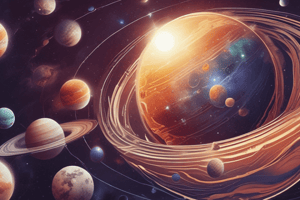Podcast
Questions and Answers
Which planet is known for being the hottest in the solar system?
Which planet is known for being the hottest in the solar system?
- Mercury
- Mars
- Jupiter
- Venus (correct)
Which of the following planets is NOT a gas giant?
Which of the following planets is NOT a gas giant?
- Uranus
- Saturn
- Jupiter
- Mars (correct)
What is unique about Uranus' axis?
What is unique about Uranus' axis?
- It is tilted at a 45-degree angle
- It is tilted on its side (correct)
- It is tilted at a 23.5-degree angle
- It is tilted at a 90-degree angle
What is the primary composition of the gas giants?
What is the primary composition of the gas giants?
Which dwarf planet has a highly eccentric orbit?
Which dwarf planet has a highly eccentric orbit?
What percentage of Earth's surface is covered in water?
What percentage of Earth's surface is covered in water?
Flashcards are hidden until you start studying
Study Notes
Planets of the Solar System
Terrestrial Planets
- Mercury:
- Smallest planet in our solar system
- Closest to the sun
- Rocky composition
- No atmosphere
- Mars:
- Known as the Red Planet
- Rocky composition
- Has polar ice caps
- Potential for life
- Earth:
- Only known planet to support life
- Rocky composition
- 71% water
- Atmosphere consists of 78% nitrogen, 21% oxygen
- Venus:
- Hottest planet in the solar system
- Rocky composition
- Thick atmosphere traps heat
- Volcanic surface
Gas Giants
- Jupiter:
- Largest planet in our solar system
- Gas composition (mostly hydrogen and helium)
- Stormy atmosphere (Great Red Spot)
- Many moons ( Io, Europa, Ganymede, Callisto)
- Saturn:
- Second-largest planet in our solar system
- Gas composition (mostly hydrogen and helium)
- Ring system
- Many moons (Titan, Enceladus)
- Uranus:
- Tilted axis (rotates on its side)
- Gas composition (mostly hydrogen, helium, and methane)
- Cold atmosphere
- Few moons
- Neptune:
- Coldest planet in the solar system
- Gas composition (mostly hydrogen, helium, and methane)
- Strong winds
- Few moons
Ice Giants
- Uranus:
- See above
- Neptune:
- See above
Dwarf Planets
- Pluto:
- Formerly considered the ninth planet
- Rocky and icy composition
- Small size
- Kuiper Belt object
- Eris:
- Located in the Kuiper Belt
- Rocky and icy composition
- Similar size to Pluto
- Highly eccentric orbit
- Haumea:
- Located in the Kuiper Belt
- Rocky and icy composition
- Irregular shape
- Highly eccentric orbit
Terrestrial Planets
- Mercury is the smallest planet in our solar system.
- Mercury is the closest planet to the sun.
- Mercury has a rocky composition and no atmosphere.
- Mars is known as the Red Planet due to its rocky composition.
- Mars has polar ice caps and shows potential for life.
- Earth is the only known planet to support life.
- Earth's composition is rocky, with 71% of its surface being water.
- Earth's atmosphere consists of 78% nitrogen and 21% oxygen.
Gas Giants
- Jupiter is the largest planet in our solar system.
- Jupiter has a gas composition, primarily consisting of hydrogen and helium.
- Jupiter's atmosphere is stormy, featuring the Great Red Spot.
- Jupiter has many moons, including Io, Europa, Ganymede, and Callisto.
- Saturn is the second-largest planet in our solar system.
- Saturn has a gas composition, primarily consisting of hydrogen and helium.
- Saturn features a prominent ring system.
- Saturn has many moons, including Titan and Enceladus.
- Uranus has a tilted axis, rotating on its side.
- Uranus has a gas composition, primarily consisting of hydrogen, helium, and methane.
- Uranus has a cold atmosphere and few moons.
- Neptune is the coldest planet in our solar system.
- Neptune has a gas composition, primarily consisting of hydrogen, helium, and methane.
- Neptune's atmosphere is subject to strong winds, and it has few moons.
Ice Giants
- Uranus is an Ice Giant, characterized by its tilted axis and cold atmosphere.
- Neptune is an Ice Giant, characterized by its cold atmosphere and strong winds.
Dwarf Planets
- Pluto is a dwarf planet, formerly considered the ninth planet in our solar system.
- Pluto has a rocky and icy composition and is small in size.
- Pluto is a Kuiper Belt object.
- Eris is a dwarf planet, located in the Kuiper Belt.
- Eris has a rocky and icy composition, similar in size to Pluto.
- Eris has a highly eccentric orbit.
- Haumea is a dwarf planet, located in the Kuiper Belt.
- Haumea has a rocky and icy composition, and an irregular shape.
- Haumea has a highly eccentric orbit.
Studying That Suits You
Use AI to generate personalized quizzes and flashcards to suit your learning preferences.




